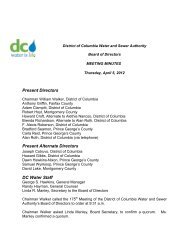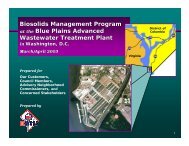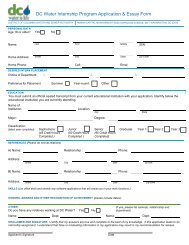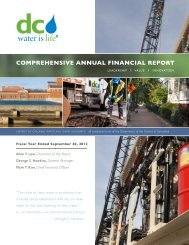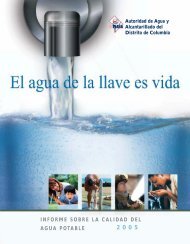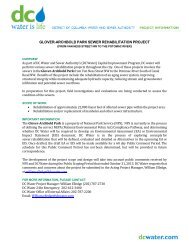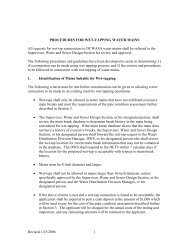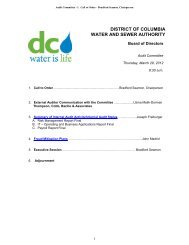2008 Annual Report - DC Water
2008 Annual Report - DC Water
2008 Annual Report - DC Water
You also want an ePaper? Increase the reach of your titles
YUMPU automatically turns print PDFs into web optimized ePapers that Google loves.
Far left: The District’s water system can be<br />
traced back to the early 1800s when water was<br />
piped from natural city springs to the Capital and<br />
to public hydrants using wooden and cast iron<br />
pipes. Here, in a 1910 photo, a <strong>DC</strong> water main is<br />
being tapped for house connections.<br />
Near Left: New $33 million, fully automated<br />
Anacostia <strong>Water</strong> Pumping Station features<br />
significant technology and capacity<br />
improvements.<br />
<strong>DC</strong> WASA revises lead pipe removal program<br />
In FY <strong>2008</strong>, the Authority Board of Directors approved a<br />
significant modification of the Lead Service Replacement<br />
(LSR) program to encourage full (public and private portions)<br />
service line replacements and to manage escalating costs.<br />
The program change was made in consultation with<br />
experts from the Centers for Disease Control, EPA, George<br />
Washington University Center for Public Health, as well as<br />
local health officials and the public.<br />
The District’s water distribution system (water mains) is<br />
virtually lead-free. However some older service lines in the<br />
District are made from lead. (The service line is the pipe that<br />
carries water from the main in the street to the home.) Some<br />
homes in the District experienced elevated lead levels in tap<br />
water samples from lead leaching from the service line. In<br />
2004, <strong>DC</strong> WASA began an accelerated program to replace<br />
all public lead service lines, and through the end of FY <strong>2008</strong>,<br />
nearly half of the estimated 35,000 public lead lines had been<br />
replaced. Since 2005, following a change in water chemistry<br />
and a significant reduction in lead levels, District drinking<br />
water has met federal limits for lead and is in full compliance<br />
with all U.S. Safe Drinking <strong>Water</strong> Act regulations.<br />
Recent studies emphasize the importance of replacing<br />
the entire (public and private portions) lead service line.<br />
The modified LSR program encourages property owners<br />
to replace the private portion of the pipe and defers $178<br />
million in program costs through 2010. The modified program<br />
continues lead service replacements during scheduled<br />
water main work. Additionally, if the private side is replaced,<br />
<strong>DC</strong> WASA will replace the public portion of the lead line<br />
on request and in coordination with other transportation<br />
department work in the area.<br />
<strong>Report</strong> shows District of Columbia well<br />
protected by public water system<br />
An analysis and evaluation of areas of the city serviced<br />
by smaller-diameter (8-, 6-, 4-inch) water mains was<br />
undertaken to ensure the availability of sufficient water flows<br />
from hydrants to fight fires. Small diameter mains make up<br />
approximately 900 miles of the city’s 1,300-mile distribution<br />
system. The report identified a one block, populated area that<br />
did not meet the fire flow guidelines, and a new 12-inch water<br />
main was expeditiously installed. Available water in the area<br />
now exceeds the fire department criteria.<br />
Hydrant Upgrade Program on target<br />
<strong>DC</strong> WASA launched an aggressive $26.5 million Fire Hydrant<br />
Upgrade Program in FY 2006 to replace nearly 3,000 public<br />
hydrants (approximately 35 percent of the District hydrants)<br />
over a five-year period. In the past two years alone, <strong>DC</strong><br />
WASA has replaced almost 2,400 hydrants, representing<br />
almost 26 percent of the entire system. More than half of the<br />
hydrants replaced were working hydrants that did not meet<br />
the national design<br />
standard. <strong>DC</strong> WASA<br />
and <strong>DC</strong> Fire and<br />
Emergency Medical<br />
Services have formed<br />
a partnership that<br />
includes biannual<br />
inspections using<br />
state-of-the-art<br />
technology and<br />
equipment, as well as<br />
an aggressive hydrant<br />
repair and upgrade<br />
program.<br />
Above: The <strong>Water</strong> Quality <strong>Report</strong> is an<br />
annual update to consumers on the source<br />
and quality of the water <strong>DC</strong> WASA delivers.<br />
dcwasa essential to Life. 18<br />
<strong>2008</strong> a n n u a l re p o r t



